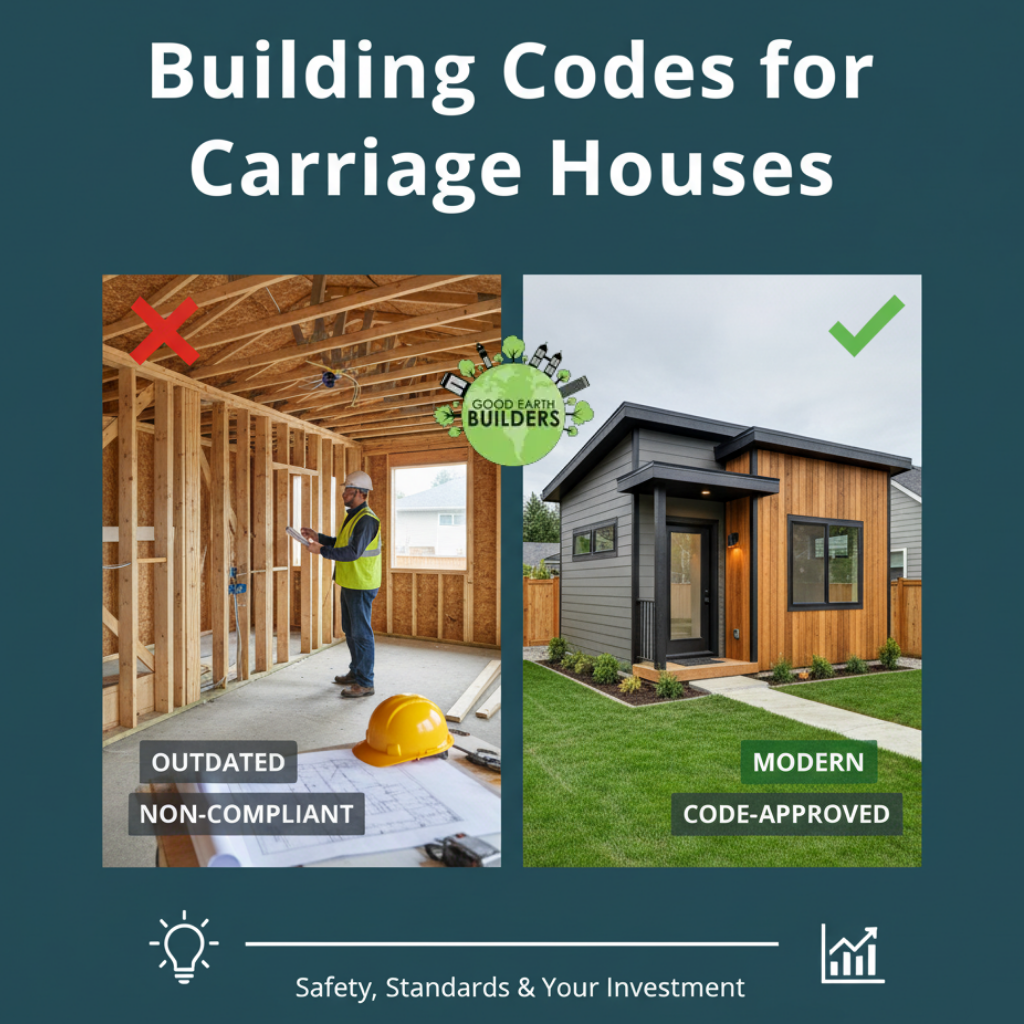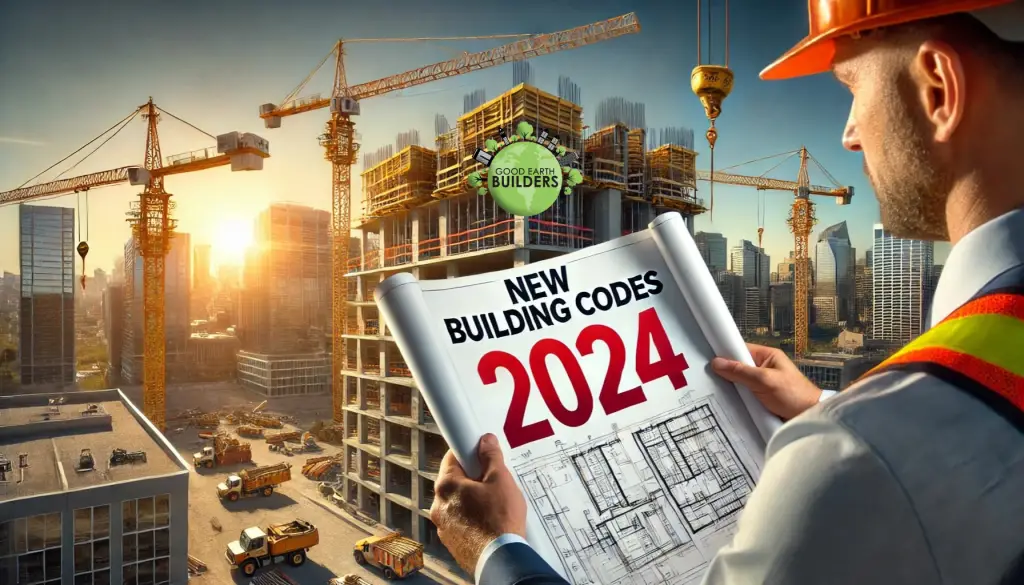Monday, October 27, 2025
The High Cost of Cutting Corners: Why Codes Matter More Than Your Design
The dream of building a Carriage House in Calgary—that beautiful, functional secondary dwelling unit above or behind your garage—is easy to fall in love with. It promises passive rental income, a private space for family, or the ultimate home office. Homeowners spend countless hours perfecting the floor plan, selecting finishes, and dreaming of the finished product. The prospect of financial returns and added utility is highly motivating, leading many to overlook the foundational requirements that ensure the project’s success.
However, many homeowners make a single, critical error that can turn that dream into an expensive, protracted nightmare: underestimating the building codes and city bylaws. The planning process is not just an administrative hurdle; it is the design blueprint for safety and legality. Failing to properly account for these regulations is the number one cause of budget overruns and schedule delays in Calgary’s residential construction sector.
In Calgary, building a Carriage House (often referred to in the bylaws as a Backyard Suite or Garage Suite) means navigating two complex layers of regulation: the City of Calgary Land Use Bylaw (Zoning) and the Alberta Building Code (Construction and Safety). These two sets of rules—one governing location and size, the other governing how the structure is built—must be perfectly aligned. Failing to comply with either can result in costly, project-destroying consequences, including:
- Stop Work Orders: Halting construction immediately, often for weeks or months, incurring daily carrying costs and contractor penalties.
- Massive Rework and Demolition: Being forced to tear down finished sections (like incorrectly built fire-rated walls or foundations) at great expense, which can double the material and labour costs for that specific phase.
- Legal Invalidation: Your suite being deemed an illegal rental unit, voiding your insurance, preventing you from registering it with the City, and creating major roadblocks when you try to sell the property.
This guide is engineered to simplify the most common and most expensive pitfalls in the Calgary process, helping you build a safe, legal, and profitable Carriage House right the first time. We will translate the often-confusing legal language into simple, human-understandable English.
I. Core Zoning & Permit Pitfalls: The Mistakes Made Before Groundbreaking
The very first set of rules you must conquer are the Land Use Bylaws. These rules govern where and how large your structure can be. These are the rules that must be satisfied to get your initial Development Permit (DP) approved by the City’s Planning Department. A rejected DP means your design is fundamentally flawed in relation to your property.
1. Miscalculating the Setbacks: Where Can It Actually Sit?
This is the most common and costliest planning mistake. You can’t simply build your Carriage House wherever you want on your lot. The structure must maintain minimum clearances, known as setbacks, from all property lines and the main residence.
- The Problem: Homeowners often rely on inaccurate measurements or outdated bylaw information. Even an error of a few centimeters can lead to a rejected permit and mandatory redesign. If construction begins without the correct setback measurements, the foundation itself is non-compliant.
- The Calgary Bylaw Focus:
- Rear Setback (Lane): Typically, a minimum of 1.2 to 1.5 meters (4 to 5 feet) from the rear property line (the lane). This distance is essential for utility access, snow removal, and crucial fire safety separation.
- Side Setbacks: Minimum clearances are usually required from the side property lines, often around 1.2 meters (3.9 feet). This ensures access for maintenance and limits visual intrusion on neighbors.
- Separation from the Main House: The City requires a minimum separation between the main house and the Carriage House, often 3.0 to 5.0 meters (10 to 16.4 feet). This distance is a critical fire safety measure that homeowners often overlook when planning their usable yard space, especially on smaller city lots.
- Costly Consequence: If you pour a foundation that encroaches on the setback, you may have to apply for a costly, drawn-out Relaxation (a formal request for permission to bend the rules, which may be denied) or, worse, hire specialized equipment to demolish and re-pour the non-compliant section of the foundation.
2. Ignoring Height and Size Limitations
Calgary bylaws place hard caps on the mass and visibility of your Carriage House to ensure it fits the character of the neighbourhood and doesn’t create excessive shadowing or bulk.
- The Problem: Designing a structure that is too tall or too large relative to your main house and lot size. This often happens when builders prioritize square footage over neighborhood context.
- The Calgary Bylaw Focus:
- Maximum Height: Generally, the maximum building height for a Carriage House is 7.5 meters (24.6 feet). Critically, some districts require the roof line to slope down toward the neighbouring property to minimize visual bulk and shadowing.
- Size Restriction: The secondary suite unit (the living space) typically has a maximum size cap (e.g., around 75 to 85 square meters, or roughly 800-900 square feet). A hard red line that must not be crossed is that the Carriage House cannot be the same size or larger than the main house in terms of total floor area or overall building envelope.
- The Shadowing Rule: On some larger or complex lots, or in high-density zones, the City may require a Shadow Impact Study to ensure the new structure doesn’t cast excessive shadows onto a neighbour’s primary outdoor amenity space during key periods of the day. This study is an added cost and a potential source of design revision.
3. Parking Stall Requirements (The Rental Trap)
If you plan to rent the suite, the City requires that you address the impact on local street parking.
- The Problem: Assuming the garage below the suite counts as your main house parking, leaving the tenant nowhere to legally park, or providing parking stalls that are too small.
- The Calgary Bylaw Focus: You will generally be required to provide at least one additional on-site parking stall for the secondary suite, separate from the primary residence’s required parking. These stalls have specific minimum dimensions (e.g., typically 2.5 m wide x 5.9 m long) and must be accessible from the lane.
- Actionable Tip: Ensure your site plan clearly labels and dimensions all required parking spaces, and confirm that the access path to the lane meets the required width and clearance standards for emergency vehicles.
II. Essential Structural & Fire Safety Codes: The Alberta Building Code
Once you have your Development Permit, you must satisfy the technical requirements of the Building Permit (BP) application, which is governed by the National Building Code – Alberta Edition and is focused on safety, structural integrity, and occupant protection. These are the non-negotiable rules that directly affect the integrity and habitability of your structure.
4. The Fire Separation Mistake: The Costliest Error Above the Garage
Since a Carriage House places a living space directly above a garage (which stores flammable liquids, vehicles, and combustion appliances), fire separation is the single most critical and most commonly failed inspection.
- The Problem: Failing to achieve the required 1-hour fire resistance rating between the garage space and the living unit above. This is not simple drywall; it is a specific assembly designed to buy occupants 60 minutes of escape time.
- The Code Focus (Section 9.10): This rating requires specific construction assemblies:
- Ceiling/Floor Assembly: Requires two layers of Type X fire-rated gypsum board (drywall) on the garage ceiling, installed using a very specific pattern (e.g., staggered seams, specific screw spacing), or sometimes a special resilient channel to prevent vibration and heat transfer.
- Supporting Structure: The joists, beams, and columns that support the floor above the garage must also be fire-rated to the same level. This means standard unprotected wood beams are often not acceptable and may need fire-rated encapsulation.
- Doors: Any door connecting the garage to a mechanical room or common area must be a fire-rated, self-closing door with proper weather stripping.
- Costly Consequence: If the inspector finds the fire separation deficient, you may be forced to tear down the entire ceiling (and potentially walls) to fix the installation after all electrical, plumbing, and HVAC rough-ins are complete. This is financially devastating because of the destruction of newly installed infrastructure.
5. Egress Windows: Your Tenant’s Lifeline
A bedroom in any secondary suite must have a window that meets strict egress (exit) standards, providing an emergency escape route in case the main exit is blocked by fire or smoke.
- The Problem: Installing a standard, smaller window that fails to meet the minimum size or operational requirements for emergency escape, or placing the sill height too high off the floor.
- The Code Focus (Section 9.9): Every bedroom must have a window that can be opened from the inside without tools or special knowledge, providing a clear opening of:
- A minimum area of 0.35 square meters (3.77 sq ft).
- The shortest side must be no less than 380 mm (15 inches).
- The window sill height must be no more than 1.5 meters (5 feet) from the finished floor (lower is always better for emergency use).
- Actionable Tip: Always specify and confirm egress windows with your supplier and installer. Never assume a large window is compliant; only the clear opening size matters.
6. The Foundation Load: Building Two Stories on a One-Story Slab
Many homeowners try to save money by retrofitting an existing garage foundation to support their new Carriage House.
- The Problem: The existing concrete slab designed to hold a car is structurally inadequate to support the massive additional load of a second-storey apartment, heavy roof trusses, and the significant snow loads typical of a Calgary winter.
- The Code Focus: The new two-storey structure requires a robust, engineered foundation (footings and potential piles) that goes deep enough to resist Calgary’s frost depth (typically 4 feet/1.2 meters or more) and has the proper rebar reinforcement to bear the weight. This must be designed and stamped by a professional structural engineer.
- Costly Consequence: Using an old, uncertified foundation means guaranteed failure in the structural inspection, potentially requiring the costly and disruptive process of underpinning the existing foundation (excavating beneath and adding support) or complete demolition and re-pouring of the slab and footings. You must start with a foundation designed for two stories.
III. The Technical Traps: MEP, Energy, and Utility Separation
The mechanical, electrical, and plumbing systems (MEP) are complex and often where hidden costs emerge due to code non-compliance and the requirement for independent systems.
7. Separate Utility Services: The Metering and HVAC Mismatch
For a legal, rentable secondary suite, the services must be separated for safety and operational reasons.
- The Problem: Running the new suite’s heat, electricity, and hot water off the main house’s existing meter and furnace. This creates major fire risks, tenant disputes over utility bills, and is often a code violation.
- The Code Focus: The National Building Code – Alberta Edition often requires:
- Independent Heating/Ventilation: The suite needs its own independent heating and ventilation system. This means installing a separate furnace/boiler or other independent, permanent heating sources and dedicated ventilation. You cannot simply tap into the main home’s ductwork. This is essential to prevent air, odour, and gas transfer.
- Separate Electrical Service: While not always mandatory, having a separate electrical meter (separate ENMAX service) for the suite is highly recommended for legal tenancy and is often a permit requirement depending on the service size. Your main house’s existing electrical service (e.g., 100 or 200 amps) must be calculated to handle the additional load of the new suite. If the service is insufficient, a costly service upgrade is required.
- Costly Consequence: Trenching and installing new utility lines (gas, power, sewer) to the suite from the main service connection is an expensive process often underestimated in the initial budget.
8. Energy Efficiency (Part 9.36 of the Code)
The Alberta Building Code has strict requirements regarding energy consumption (Part 9.36) for all new construction.
- The Problem: Using outdated insulation standards, ignoring air sealing details, or failing to document compliance properly.
- The Code Focus: You must meet minimum R-values for all exterior assemblies (walls, ceilings, floors) for the Calgary climate. This requires proper insulation installation, a continuous air barrier (vapour barrier), and often an Energy Step Code Compliance Path that requires documentation (like the 9.36 Project Summary Form) signed off by an energy modeler or qualified professional.
- Costly Consequence: If the insulation is installed without the proper vapour barrier or fails to meet the required R-value, all the drywall must be removed and replaced to fix the envelope—a disaster for the schedule and budget that impacts every other trade that follows.
9. Garage Ventilation and Carbon Monoxide Safety
The air quality separation between the garage and the living space must be absolute for occupant health.
- The Problem: Permitting vehicle exhaust fumes, carbon monoxide (CO), and gas vapours to enter the living space. This is a life-safety issue.
- The Code Focus:
- A complete air barrier system must be installed to provide an effective barrier against gas and exhaust fumes rising from the garage to the suite.
- The garage space requires specific mechanical ventilation to meet air changes per hour (ACH) requirements to purge harmful vapours.
- CO and Smoke Alarms: All secondary suites are required to have interconnected smoke alarms and carbon monoxide alarms. The activation of one alarm in the suite must cause all alarms in both the main house and the suite to sound.
IV. How to Guarantee Compliance: Build Smart, Not Twice
The common theme in all these costly mistakes is a failure in the planning and design phase. When you try to save money by bypassing professionals, you almost always pay ten-fold in the construction phase. The path to efficiency is through early, accurate investment in expertise.
A. The Importance of Professional Partnerships
- Invest in Professional Design: Hire a qualified Calgary-based architectural technologist, designer, or architect who specializes in secondary suites. Their expertise is not just in aesthetics, but in translating the complex Land Use Bylaw and Building Code into a permit-ready, compliant set of drawings. They understand the City’s submission requirements and typical points of failure.
- Do Not Skimp on Engineering: Require a stamped structural engineer’s plan for your foundation and framing. The upfront cost ($3,000–$7,000) is negligible compared to the cost of a failed foundation inspection and subsequent structural rework. This is insurance for the safety and longevity of your structure.
- Vet Your Contractor: The best defense against code mistakes is an experienced General Contractor (GC) who has a strong, successful track record with Calgary’s Development Permit and Building Permit processes. They know the inspectors, they know the most current codes, and they have established relationships with certified trades (plumbing, electrical, gas) who execute compliant work.
B. Mastering the City Inspection Process
- Respect the Inspection Process: The City’s Safety Code Officers (inspectors) are your final line of defense against an illegal, unsafe build. Respect the mandatory hold points (e.g., foundation, framing rough-in, insulation). Never cover up work before it has been officially signed off. Failing to do so will result in a “Do Not Cover” order and may require you to tear out finished work, wasting time and materials.
- Maintain Clear Documentation: Keep a digital copy of all approved drawings and permits on-site. Ensure your trades are always working from the latest, stamped version of the plans.
V. The Full Circle: From Compliance to Excellence
Maximizing efficiency in your Carriage House build is not about speed; it’s about precision and predictability. Every hour spent meticulously detailing the plans to meet Calgary’s complex codes is an hour saved in the field, avoiding demolition, rework, and delays. A compliant build is a safe build, a legal build, and ultimately, a profitable investment that adds real, verifiable value to your property.
⭐ Partner with a Builder Driven by Code Compliance and Quality: Good Earth Builders
Navigating the essential building codes for a Calgary Carriage House requires more than just good intentions—it demands expertise, precision, and local knowledge that few builders possess. At Good Earth Builders, we recognize that achieving a flawless build means making compliance the first step, not an afterthought.
For over two decades, we have specialized in complex residential projects, including high-value, high-compliance builds like Calgary Carriage Houses. Our entire process is designed specifically to eliminate the “Costly Mistakes” outlined above:
- Guaranteed Permit Success: Our in-house VDC (Virtual Design and Construction) team works directly with our pre-vetted designers and engineers. We proactively analyze your design against the City of Calgary’s Land Use Bylaws and the Alberta Building Code before the first submission, ensuring a smooth, predictable path to permit approval.
- Expert Fire Separation Systems: We utilize superior materials and precision installation techniques to ensure that the critical fire separation between your garage and suite is constructed flawlessly, meeting or exceeding all mandatory safety ratings the first time. We document every layer for a guaranteed inspection pass.
- Engineered Foundations as Standard: We never compromise on the structural integrity of a two-storey structure. Every Carriage House we build sits on a robust, engineer-stamped foundation designed specifically for the load and Calgary’s unique soil and frost conditions.
Building a Carriage House should be an exciting journey, not a series of expensive roadblocks. When you partner with Good Earth Builders, you gain a team whose reputation is built on predictable schedules, rigorous code compliance, and superior quality, ensuring your investment is safe, legal, and profitable for years to come.
Ready to move forward with a Calgary Carriage House build that is guaranteed to pass inspection?
📞Contact Good Earth Builders today for a no-obligation consultation and let us transform your laneway space into a compliant, high-value asset.




